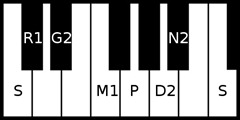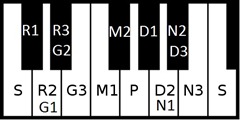The scales of Sindhu Bhairavi are as follows :
Aarohanam (Ascending) : S R2 G2 M1 G2 P D1 N2 S’
Avarohanam (Descending) : N2 D1 P M1 G2 R1 S N2 S
This is a janya raga, derived from Natakapriya (see below), 10th on the Melakarta scale. However, some say that Sindhu Bhairavi as sung now is a derivative of 8th Melakarta Hanumatodi and 20th Melakarta Natabhairavi asboth R1 and R2 are used in this raga. I have also read that there it is not a raga which can be so classified because all 12 notes can be used (some sparingly). I understand that the raga has origins in the Middle East.
In Carnatic concerts, this raga is not often used for elaborations but for light numbers or bhajans towards the end. It is indeed quite regularly sung. The beautiful Thillana by Lalgudi Jayaraman will be familiar to all as also Swati Thirunal’s Bhaja Bhaja Manasa and Vishveshvar Darshan Kar, Iduvo Thillai by Gopalakrishna Bharati.
For Tamil speakers, here is a lec-dem by Charulata Mani on this raga.
Note : The 12 notes in the octave are named as below. Please note that C is used as Sa for the sake of simplicity as the scale is relative in Carnatic Music. Also note that the scales paint only a superficial picture of the raga as the gamakas(ornamentations) are a very important part of a raga.




I can’t find the actual arohana and avarohana of the raga
Sorry? It’s there..
I have not found any evidence of Koran being sung in Sindh Bhairavi…what is your source for this assertion?
Oh heavens, I wrote this many years back and who knows what I referred to when I wrote that? I’m sorry, I should have noted references but my blog was never meant to be an academic exercise. The azaan is sometimes recited in Sindhu Bhairavi (I googled a reference, there is one in the last line of this article https://indianexpress.com/article/opinion/kishori-amonkars-music-her-dying-her-bhairavi-took-us-to-the-depths-of-our-soul-4688215/) . As I cannot remember my source, I will delete the relevant sentence but will do some research when I next have some time.
Cheers. Suja
Hats off for your effort you done for this blog. If there was a chance to know the ragas’ arohana and avarohana , it will be useful to refer academic level too. Best wishes for your future planning on this matter.
You have made the same comment before but this is not an academic blog. The purpose is music appreciation for listeners. I am not qualified to write about anything academic.
Cheers. Suja
please note that both Muthu Mani malai from Chinna Counder and Chingari in hindi are both in this raag Am I correct
I am not that familiar with Tamil film music but yes, Chingari is based on Hindustani Bhairavi, an equivalent of Sindhu Bhairavi in Carnatic music. Of course, being filmi music, the raga is not strictly adhered to.
Cheers. Suja
Sindhu Bhairavi doesn’t have D2, its D1. Please correct your mistake then I’ll delete this comment.
I mean in the PICTURE of Swaras.
As mentioned on the text, the picture is of NATAKAPRIYA
Is it D1 or not? All black keys on piano right?
Yes, it is D1.
It’s c Minor Right